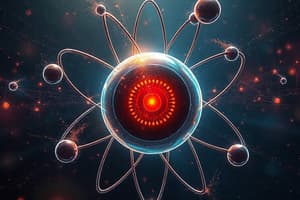Podcast
Questions and Answers
What did Democritus contribute to the understanding of atomic theory?
What did Democritus contribute to the understanding of atomic theory?
- Proposed that atoms are indivisible particles. (correct)
- Developed the plum pudding model.
- Discovered the nucleus.
- Introduced the concept of energy levels for electrons.
Which of the following statements best describes John Dalton's atomic theory?
Which of the following statements best describes John Dalton's atomic theory?
- Atoms of the same element have different masses.
- Atoms combine in whole-number ratios to form compounds. (correct)
- Atoms can be created and destroyed in chemical reactions.
- Electrons are scattered throughout a positively charged sphere.
What is the main idea behind the plum pudding model proposed by J.J. Thomson?
What is the main idea behind the plum pudding model proposed by J.J. Thomson?
- Atoms are indivisible and indestructible.
- Electrons have fixed orbits around a nucleus.
- Electrons are scattered throughout a positively charged sphere. (correct)
- Atoms consist of a dense, positively charged nucleus.
What was a significant outcome of Ernest Rutherford's gold foil experiment?
What was a significant outcome of Ernest Rutherford's gold foil experiment?
In the Bohr model of the atom, how do electrons move between energy levels?
In the Bohr model of the atom, how do electrons move between energy levels?
Which of the following is an example of a physical change?
Which of the following is an example of a physical change?
What characterizes a chemical property of a substance?
What characterizes a chemical property of a substance?
Which of the following is NOT a physical property of a substance?
Which of the following is NOT a physical property of a substance?
Which of the following is a characteristic of noble gases?
Which of the following is a characteristic of noble gases?
Which statement best describes a cation?
Which statement best describes a cation?
Which group of the periodic table contains nonmetals that can be highly reactive?
Which group of the periodic table contains nonmetals that can be highly reactive?
What defines a chemical change?
What defines a chemical change?
Which of the following statements about isotopes is true?
Which of the following statements about isotopes is true?
Which of the following elements belongs to the alkaline earth metals group?
Which of the following elements belongs to the alkaline earth metals group?
What happens when iron reacts with oxygen gas?
What happens when iron reacts with oxygen gas?
Which property is characteristic of metalloids?
Which property is characteristic of metalloids?
What is the process of combustion primarily characterized by?
What is the process of combustion primarily characterized by?
Which property describes a material's ability to be drawn into a wire?
Which property describes a material's ability to be drawn into a wire?
What term refers to the degradation of metals due to their reaction with the environment?
What term refers to the degradation of metals due to their reaction with the environment?
Which characteristic of a substance is indicated by its viscosity?
Which characteristic of a substance is indicated by its viscosity?
What does solubility measure in a substance?
What does solubility measure in a substance?
What distinguishes Carbon-12 from Carbon-13 and Carbon-14?
What distinguishes Carbon-12 from Carbon-13 and Carbon-14?
Which of the following best describes a molecule?
Which of the following best describes a molecule?
Which of these is a characteristic of physical properties?
Which of these is a characteristic of physical properties?
What occurs during a chemical change?
What occurs during a chemical change?
How many electrons can the third shell of an atom hold?
How many electrons can the third shell of an atom hold?
Which property refers to how quickly a substance ignites?
Which property refers to how quickly a substance ignites?
Which of the following examples involves a physical change?
Which of the following examples involves a physical change?
What is the central part of an atom that contains protons and neutrons called?
What is the central part of an atom that contains protons and neutrons called?
Flashcards are hidden until you start studying
Study Notes
History of the Atom
- Democritus proposed the idea of atoms as indivisible particles, differing in shape and size.
- John Dalton developed the first modern atomic theory, stating that elements are composed of unique atoms, which are indivisible, indestructible, and identical in mass and properties.
- J.J. Thomson discovered the electron using cathode ray tubes, leading to the "plum pudding" model where electrons were scattered in a positively charged sphere.
- Ernest Rutherford's gold foil experiment led to the discovery of the nucleus, resulting in the nuclear model.
- Niels Bohr introduced the Bohr model, proposing that electrons orbit the nucleus in specific energy levels and can move between them by absorbing or emitting energy.
Physical and Chemical Properties
- Physical properties can be observed without changing the substance's chemical composition. Examples include color, melting point, density, and solubility.
- Chemical properties describe a substance’s behavior when it undergoes a change to form a new substance. Examples include reactivity with acids, flammability, and oxidation states.
Physical and Chemical Changes
- Physical changes alter the form or state of a substance, but not its chemical composition. Examples include melting ice, tearing paper, and making a mixture.
- Chemical changes alter the chemical composition of a substance, creating new substances. Examples include burning paper, digesting food, and iron reacting with oxygen gas.
Groups and Periods on the Periodic Table
- Alkali metals (Group 1) are highly reactive, especially with water. Examples include lithium, sodium, and potassium.
- Alkaline earth metals (Group 2) are also reactive, but less so than alkali metals. Examples include beryllium, magnesium, and calcium.
- Halogens (Group 17) are highly reactive nonmetals. Examples include fluorine, chlorine, and bromine.
- Noble gases (Group 18) are inert due to their full valence shells. Examples include helium, neon, and argon.
- Transition metals (Groups 3-12) often form colourful compounds and are good conductors. Examples include iron, copper, and gold.
- Metalloids (Groups 13-16, excluding boron) have properties between metals & nonmetals. Examples include silicon, germanium, and arsenic.
- Nonmetals (Groups 14-17, excluding noble gases) are typically dull, brittle, and non-conductive. Examples include carbon, nitrogen, and oxygen.
Ions and Isotopes
- Ions are atoms that have gained or lost electrons, resulting in a net electrical charge. Cations are positively charged, while anions are negatively charged.
- Isotopes are atoms of the same element with different numbers of neutrons, resulting in different atomic masses.
Atoms, Molecules, and Compounds
- Atoms are the basic units of matter, consisting of protons, neutrons, and electrons.
- Molecules consist of two or more atoms bonded together, which can be the same or different elements.
- Compounds are substances formed when two or more different elements chemically bond.
Bohr-Rutherford Diagram
- The nucleus is at the center of the atom, containing protons (positive charge) and neutrons (neutral charge).
- Electrons orbit the nucleus in specific energy levels called shells.
- The Bohr-Rutherford diagram depicts the atom with the nucleus at the center and circles representing electron shells, with dots or small circles representing electrons in their shells.
HHPS Safety
- The diagram illustrates safety symbols and procedures for a chemistry laboratory.
Definitions
- Physical Properties: Characteristics observable without changing the substance's chemical composition. Examples include color, density, and solubility.
- Chemical Properties: Characteristics that describe how a substance behaves when undergoing a chemical change. Examples include flammability, reactivity, and oxidation states.
- Physical Changes: Changes that alter the form or state of a substance but not its chemical composition. Examples include melting ice, tearing paper, and making a mixture.
- Chemical Changes: Changes that alter the chemical composition of a substance, creating new products. Examples include burning paper, digesting food, and iron reacting with oxygen.
- State of Matter: Describes the behavior of atoms and molecules in a substance, including solid, liquid, and gas.
- Flammability: The ability of a substance to burn and light on fire.
- Reactivity: The tendency of a substance to undergo chemical reactions.
- Decomposition: The process of rotting or decaying.
- Combustion: A chemical process involving rapid reaction with oxygen, releasing heat and light. Example: Burning wood or petrol.
- Combustibility: The ability of a substance to burn.
- Corrosion: The degradation of a metal due to a reaction with its environment. Examples include rusting of iron and tarnishing of silver.
- Ductility: The ability of a substance to be drawn into a wire.
- Texture: The feel, appearance, or consistency of a substance.
- Luster: The shine or gloss of a substance.
- Odor: A distinctive smell.
- Inert: Lacking the ability to react or move.
- Malleability: The ability of a substance to be shaped without breaking.
- Conductivity: The ability of a substance to conduct heat or electricity.
- Density: The ratio of mass to volume.
- Solubility: The degree to which a substance dissolves in a solvent.
- Viscosity: The resistance of a fluid to flow.
Studying That Suits You
Use AI to generate personalized quizzes and flashcards to suit your learning preferences.




